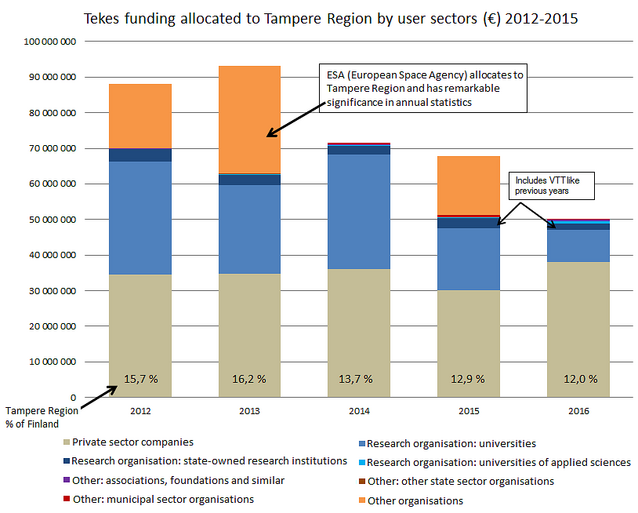Research and development expenditure continued its decline in the Tampere Region for the fifth year in a row. In 2015, research and development expenditure was EUR 0.771 billion (–7.3%). Research and development expenditure also decreased on a national level by approximatively 7%. Although the change in the scale of RDI operations seems to be continuing, investments made within the Tampere Region are still significant. In 2014, research and development expenditure was 4.8% in proportion to the GDP.
Research and development expenditure in the public and higher education sectors increased while the expenditure of enterprises decreased by over 10%. However, the research and development intensity* of the Tampere Region remains among the highest in the country and is clearly above the national average.
No sector-specific research and development expenditure data is available on a regional level, but examination of the whole country reveals that the level of research and development investments of enterprises measured in man-years seems to have actually increased, if the Nokia-oriented electronics industry is excluded from the figures. Investments in RDI operations of the cluster formed around Nokia in the Tampere Region have been significant and the reduced R&D investments of the cluster have also had a significant impact on the development of R&D expenditure in the Tampere Region.
The total budget of Tekes has declined steadily since 2010, which also shows in the reduction of funding channelled to the regions. The total share of the Tampere Region in the funding granted by Tekes was approximately 12% in 2016. The changed funding policies of Tekes are now clearly visible in the Situational Picture in the considerable drop (–43.7%) in the funding granted to research organisations and, on the other hand, in the increase (+26.4%) in funding granted to enterprises. The amount of funding granted to municipalities and joint municipal authorities has also decreased significantly, which has been influenced among other things by the end of the INKA programme in 2017. Its funding was transferred to Tekes in 2015. Although the share of the Tampere Region in the RDI funding granted by Tekes has decreased in the past few years, the share of the Tampere Region in the funding granted to enterprises has stayed relatively stable.
Enterprises based in the Tampere Region were more active in applying for funding from Tekes than in the previous years, but the total value of the funding applications stayed at the last year’s level. This means that the number of projects has increased but their value has decreased. The funding granted to enterprises totalled approximately EUR 38 million.
Innovation voucher to speed up RDI operations of enterprises
The innovation voucher project pilots in a concrete manner a new kind of financing instrument and electronic service system in cooperation with SMEs. The purpose of the service supported by the voucher is to lower the threshold for using innovation and growth services and to activate RDI activities of enterprises. A service purchased with an innovation voucher must be a significant initiative or step towards something new for the enterprise. Fields to be developed include smart transport, IoT, well-being, renewing industry and other solutions for smart urban development. Read more in Jukka Reunavuori’s article.
Information on risk funding granted to growth companies is obtained via data reported by capital investors. In 2016, enterprises in the Tampere Region accumulated a total of EUR 8.4 million in venture transactions. This amount was divided among 11 enterprises. Risk funding is characterised by major variations in funding amounts between different years.
Higher education institutes have been successful in accumulating more funding from private sources (+13.4%) and international sources, such as EU funding, (+25.3%) than in the previous year. The increase in private funding is explained by the increase in domestic, private funding. Higher education institutes seem to have successfully compensated for the loss in funding flow caused, for example, by the Tekes policies.
*companies’ R&D expenditures / companies’ turnover x 100
